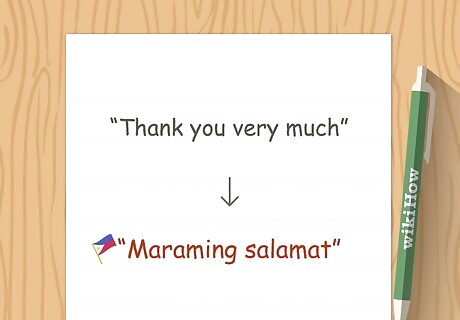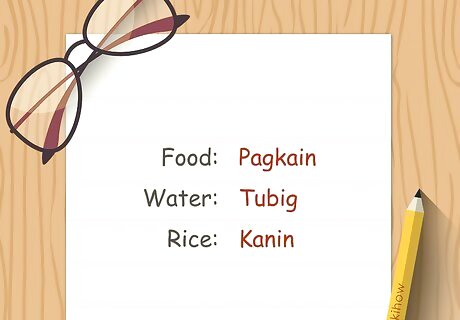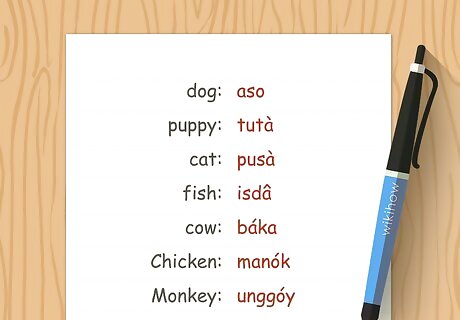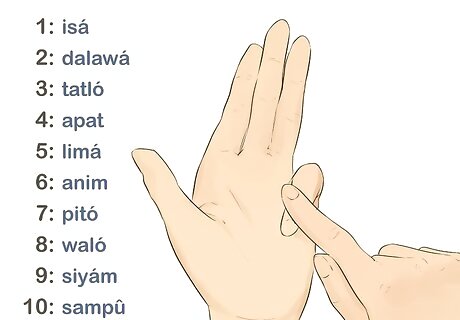
views
Learning Common Words and Phrases

Work on some common greetings. By practicing these phrases, you'll be able to greet friends and strangers alike in Tagalog. Good morning: Magandáng umaga Good afternoon: Magandáng hapon Good evening: Magandáng gabí Hi: Hi Bye: Paalam

Pick up on “yes,” “no,” “thank you,” and similar key terms. Both “yes” and “no” have informal and formal versions in Tagalog. For “yes,” say "opo” when talking to social superiors, such as people from an older generation, one's boss or teacher, or even the President or royalty. Simply use "oo" for "yes" for one's equals, those younger than you, or those of a lower social rank than you. Yes: Oo (informal) / Opo (formal) No: Hindi (informal) / Hindi po (formal) Thank you: Salamat po Thank you very much: Maraming salamat You're welcome: Waláng anumán (literally, "nothing at all") "Po" is the correct word to show respect. Technically, it means "sir" or "ma'am.” Add it after the phrase, such as with the formal “yes” and “no” or “thank you.”

Practice other common conversational phrases. With these, you'll be able to build upon greetings and conduct simple conversations. And if you have to mix in some English along the way to make your point, you'll probably be OK, since many Filipinos speak some English. But they're usually happy when you at least try to speak some Tagalog! My name is: Ang pangalan ko ay (your name) Are you OK?: Ayos ka lang ba? How are you?: Kamusta ka na? I'm fine: Ayos lang I love you: Mahál kitá How much does it cost?: Magkano ba ito? Where is the restroom?: Nasaán ang banyo?

Identify a few key food terms by name. Build your food vocabulary with the absolute basics, then you can slowly add in other names for foods and drinks. Food: Pagkain Water: Tubig Rice: Kanin

Learn several helpful food phrases. In addition to naming foods, it's helpful to be able to make requests and describe your feelings regarding a meal. These phrases will help you converse with wait staff at a restaurant. Delicious: Masaráp I'm hungry: Gutóm na ako I'd like some food, please: Pakibigyán niyo po ako ng pagkain The food was delicious: Masaráp ang pagkain.

Add some useful descriptive terms. Learning some key adverbs and adjectives will help you to describe your surroundings and how you feel. They can help advance your Tagalog skills beyond the absolute basics. Beautiful: Maganda Ugly: Pangit Nice: Mabaít Help: Tulong Helpful: Matulungín Dirty: Marumí Clean: Malinis Respect: Paggalang Respectful: Magalang

Identify names for family members. These terms will help you to discuss your own family, and also meet and greet the family of your friends and new acquaintances. Mother: Iná Father: Amá Sister (eldest): Ate Brother (eldest): Kuyà Youngest sibling: Bunsô Grandma: Lola Grandpa: Lolo Uncle: Tito Aunt: Tita Niece/Nephew: Pamangkín Cousin: Pinsan

Name some common animals in Tagalog. These might come in handy if you want to talk about your pets, or if you visit a farm in the Philippines! Dog: Aso Puppy: Tutà Cat: Pusà Fish: Isdâ Cow: Báka Chicken: Manók Monkey: Unggóy

Count from 1-10 in Tagalog. Counting terms will help you when you're dealing with money, especially if you're bargaining for a better price. You'll also be able to tell your new friends how many more days your trip to the Philippines is going to last! 1: isá 2: dalawá 3: tatló 4: apat 5: limá 6: anim 7: pitó 8: waló 9: siyám 10: sampû
Getting Practice Speaking Tagalog

Sound out Tagalog words phonetically as you begin learning. With its origins in several native languages, a heavy dose of Spanish, and a growing English influence, you might think Tagalog pronunciation would be a real challenge. However, when it is adapted to the Latin alphabet (which is now most common in the Philippines), the language is almost entirely phonetic—that is, the words sound the way they look. So, if you “sound out” a word in Tagalog, you'll likely be pretty close on the correct pronunciation. Check out, for instance, the following examples, in which the Tagalog words are phonetic forms of their English counterparts: Automobile / Awtomobil; Economics / Ekonomiks; Website / Websayt. With further practice and immersion in the language, you'll be able to pick up on some of the limited phonetic variations in Tagalog.

Listen to Tagalog-speakers converse, and try to join in! Immersing yourself in a language by listening to native speakers converse can be a great way to pick up the most commonly-used words and phrases. If you have Filipino friends, ask them to converse in the language and try to follow along with them. Ask them for tips along the way and try your hand at saying some key words and phrases. If you have a background in English or Spanish, you'll likely pick up on many phonetic (sound-alike) connections to Tagalog. These can help you follow along and pick up new words more quickly. If you're in the Philippines, try to follow Tagalog conversations and ask questions or for clarifications in English. Most Filipinos speak a fair amount of English, and they're usually happy to help someone who wants to pick up some Tagalog!

Watch Tagalog videos or shows with subtitles on. Search online video platforms for Tagalog-language videos and turn the subtitles on. Or, if you have access to Tagalog TV programs, try watching them with subtitles. In either case, you'll gain familiarity with common words and phrases in Tagalog. A quick search on YouTube or similar video sites will provide you with a wide range of Tagalog-language videos with subtitles.

Search for free or pay-to-use Tagalog learning programs. A quick search will reveal many options for learning Tagalog online. Start by looking at free options, as these are sometimes of equal or better quality than paid alternatives. You'll probably have the most luck with programs that include audio, video, and text components. Though it may seem a bit old-fashioned, creating flash cards with Tagalog words/phrases can be a helpful way to build your vocabulary. Many online programs utilize some form of flash card-style learning.

Focus on the most commonly-used words and phrases. In Tagalog and most other languages, native speakers primarily use about 300-500 different words per day, and have an overall vocabulary of around 3,000-5,000 words. So, if you focus on picking up the everyday words and phrases, you'll be able to manage well among Tagalog speakers. Prioritize becoming conversant in everyday Tagalog, then spend time learning the finer details of the language, pronunciation, grammar, and so on.



















Comments
0 comment